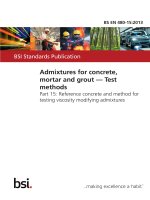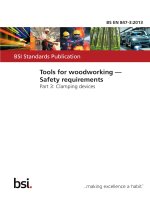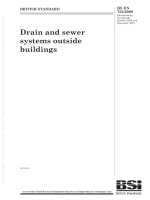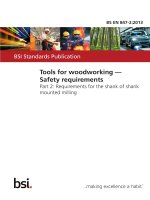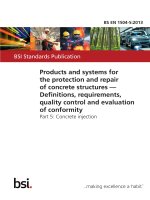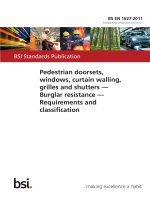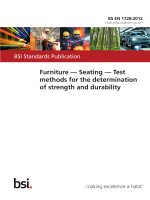Bsi bs en 62325 450 2013
Bạn đang xem bản rút gọn của tài liệu. Xem và tải ngay bản đầy đủ của tài liệu tại đây (1.53 MB, 34 trang )
BS EN 62325-450:2013
BSI Standards Publication
Framework for energy
market communications
Part 450: Profile and context
modelling rules
BRITISH STANDARD
BS EN 62325-450:2013
National foreword
This British Standard is the UK implementation of EN 62325-450:2013. It is
identical to IEC 62325-450:2013.
The UK participation in its preparation was entrusted to Technical
Committee PEL/57, Power systems management and associated
information exchange.
A list of organizations represented on this committee can be obtained on
request to its secretary.
This publication does not purport to include all the necessary provisions of
a contract. Users are responsible for its correct application.
© The British Standards Institution 2013.
Published by BSI Standards Limited 2013
ISBN 978 0 580 71520 4
ICS 33.200
Compliance with a British Standard cannot confer immunity from
legal obligations.
This British Standard was published under the authority of the
Standards Policy and Strategy Committee on 31 August 2013.
Amendments/corrigenda issued since publication
Date
Text affected
BS EN 62325-450:2013
EN 62325-450
EUROPEAN STANDARD
NORME EUROPÉENNE
EUROPÄISCHE NORM
August 2013
ICS 33.200
English version
Framework for energy market communications Part 450: Profile and context modelling rules
(IEC 62325-450:2013)
Cadre pour les communications pour le
marché de l'énergie Partie 450: Règles de modélisation de
profils et de contextes
(CEI 62325-450:2013)
Kommunikation im Energiemarkt Teil 450: Profil- und KontextModellierungsregeln
(IEC 62325-450:2013)
This European Standard was approved by CENELEC on 2013-06-03. CENELEC members are bound to comply
with the CEN/CENELEC Internal Regulations which stipulate the conditions for giving this European Standard
the status of a national standard without any alteration.
Up-to-date lists and bibliographical references concerning such national standards may be obtained on
application to the CEN-CENELEC Management Centre or to any CENELEC member.
This European Standard exists in three official versions (English, French, German). A version in any other
language made by translation under the responsibility of a CENELEC member into its own language and notified
to the CEN-CENELEC Management Centre has the same status as the official versions.
CENELEC members are the national electrotechnical committees of Austria, Belgium, Bulgaria, Croatia, Cyprus,
the Czech Republic, Denmark, Estonia, Finland, Former Yugoslav Republic of Macedonia, France, Germany,
Greece, Hungary, Iceland, Ireland, Italy, Latvia, Lithuania, Luxembourg, Malta, the Netherlands, Norway, Poland,
Portugal, Romania, Slovakia, Slovenia, Spain, Sweden, Switzerland, Turkey and the United Kingdom.
CENELEC
European Committee for Electrotechnical Standardization
Comité Européen de Normalisation Electrotechnique
Europäisches Komitee für Elektrotechnische Normung
Management Centre: Avenue Marnix 17, B - 1000 Brussels
© 2013 CENELEC -
All rights of exploitation in any form and by any means reserved worldwide for CENELEC members.
Ref. No. EN 62325-450:2013 E
BS EN 62325-450:2013
EN 62325-450:2013
-2-
Foreword
The text of document 57/1324/FDIS, future edition 1 of IEC 62325-450, prepared by IEC TC 57 "Power
systems management and associated information exchange" was submitted to the IEC-CENELEC
parallel vote and approved by CENELEC as EN 62325-450:2013.
The following dates are fixed:
•
•
latest date by which the document has
to be implemented at national level by
publication of an identical national
standard or by endorsement
latest date by which the national
standards conflicting with the
document have to be withdrawn
(dop)
2014-03-03
(dow)
2016-06-03
Attention is drawn to the possibility that some of the elements of this document may be the subject of
patent rights. CENELEC [and/or CEN] shall not be held responsible for identifying any or all such patent
rights.
This document has been prepared under a mandate given to CENELEC by the European Commission
and the European Free Trade Association.
Endorsement notice
The text of the International Standard IEC 62325-450:2013 was approved by CENELEC as a European
Standard without any modification.
BS EN 62325-450:2013
EN 62325-450:2013
-3-
Annex ZA
(normative)
Normative references to international publications
with their corresponding European publications
The following documents, in whole or in part, are normatively referenced in this document and are
indispensable for its application. For dated references, only the edition cited applies. For undated
references, the latest edition of the referenced document (including any amendments) applies.
NOTE When an international publication has been modified by common modifications, indicated by (mod), the relevant EN/HD
applies.
Publication
Year
Title
EN/HD
Year
IEC 62325-301
-
Framework for energy market
communications Part 301: Common Information Model (CIM)
extensions for markets
EN 62325-301
-
IEC 62361-100
-
Harmonization of quality codes across TC 57 - EN 62361-100
Part 100: Naming and design rules for CIM
profiles to XML schema mapping
-
ISO/IEC 11404
-
Information technology General-Purpose Datatypes (GPD)
-
-
–2–
BS EN 62325-450:2013
62325-450 © IEC:2013
CONTENTS
INTRODUCTION ..................................................................................................................... 6
1
Scope ............................................................................................................................... 7
2
Normative references ....................................................................................................... 7
3
Terms and definitions ....................................................................................................... 8
4
General ............................................................................................................................ 9
5
4.1
4.2
4.3
Rule
6
Rules governing contextual artefact transformation ........................................................ 15
6.1
6.2
6.3
6.4
Annex A
The two methods used to generate profiles ............................................................. 9
Overview ............................................................................................................... 10
Example of modelling principles usage .................................................................. 12
breakdown structure ............................................................................................... 12
Class derivation rules ............................................................................................ 15
6.1.1 Regional contextual model class rules ....................................................... 15
6.1.2 Document contextual model class rules ..................................................... 15
Class attribute derivation rules .............................................................................. 16
6.2.1 Regional contextual model class attribute rules ......................................... 16
6.2.2 Document contextual model class attribute rules ....................................... 16
Relationship derivation rules ................................................................................. 17
6.3.1 Regional contextual model relationships rules ........................................... 17
6.3.2 Document contextual model relationships rules ......................................... 17
Datatypes .............................................................................................................. 18
6.4.1 Permitted datatypes ................................................................................... 18
6.4.2 Primitive datatypes .................................................................................... 18
6.4.3 Enumeration datatypes .............................................................................. 19
6.4.4 CIMdatatype datatypes .............................................................................. 20
6.4.5 Compound datatypes ................................................................................. 21
6.4.6 Compound attribute derivation rules .......................................................... 22
(informative) Illustrated examples of rule usage ..................................................... 23
Annex B (normative) Naming convention.............................................................................. 29
Annex C (normative) Primitive.............................................................................................. 30
Figure 1 – Differences between European and American approach ......................................... 9
Figure 2 – Modelling framework principles ............................................................................ 10
Figure 3 – Example of modelling principles usage ................................................................. 12
Figure 4 – CIM UML class diagram ....................................................................................... 13
Figure 5 – Association example ............................................................................................ 14
Figure 6 – Aggregation example ........................................................................................... 14
Figure 7 – Composition example ........................................................................................... 14
Figure A.1 – The “based on” principles ................................................................................. 23
Figure A.2 – Inherited relationship profiling examples ........................................................... 25
Figure A.3 – Step by step relationship transformation example ............................................. 26
Figure A.4 – Profiling inherited relationship general example ................................................ 27
Figure A.5 – Generalization relationship example ................................................................. 27
BS EN 62325-450:2013
62325-450 © IEC:2013
–3–
Table 1 – Regional contextual model class rules ................................................................... 15
Table 2 – Document contextual model class rules ................................................................. 16
Table 3 – Regional contextual model class rules ................................................................... 16
Table 4 – Document contextual model class attribute rules ................................................... 16
Table 5 – Regional contextual model generalization relationships rules ................................ 17
Table 6 – Regional contextual model other relationships rules .............................................. 17
Table 7 – Document contextual model generalization relationships rules .............................. 18
Table 8 – Document contextual model aggregation relationships rules .................................. 18
Table 9 – Permitted datatypes .............................................................................................. 18
Table 10 – Rules for primitive datatype derivation ................................................................. 18
Table 11 – Permitted primitive value space constraints ......................................................... 19
Table 12 – Primitive regional and document contextualized derivation rules ......................... 19
Table 13 – Regional contextual model enumeration derivation rules ..................................... 19
Table 14 – Document contextual model enumeration derivation rules ................................... 20
Table 15 – Regional contextual model CIMdatatype derivation rules ..................................... 20
Table 16 – Regional contextual model CIMdatatype attribute derivation rules ....................... 20
Table 17 – Document contextual model CIMdatatype derivation rules ................................... 21
Table 18 – Document contextual model CIMdatatype attribute derivation rules ..................... 21
Table 19 – Regional contextual model compound rules ......................................................... 21
Table 20 – Document contextual model compound rules ....................................................... 21
Table 21 – Regional contextual model compound attribute rules ........................................... 22
Table 22 – Document contextual model compound attribute rules ......................................... 22
Table B.1 – Common naming convention .............................................................................. 29
Table B.2 – Abbreviations and acronyms .............................................................................. 29
Table C.1 – Primitive ............................................................................................................ 30
–6–
BS EN 62325-450:2013
62325-450 © IEC:2013
INTRODUCTION
This standard is one of the IEC 62325 series which define protocols for deregulated energy
market communications.
The principal objective of the IEC 62325 series of standards is to produce standards which
facilitate the integration of market application software developed independently by different
vendors into a market management system, between market management systems and
market participant systems. This is accomplished by defining message exchanges to enable
these applications or systems access to public data and exchange information independent of
how such information is represented internally.
The common information model (CIM 1) specifies the basis for the semantics for this message
exchange.
The profile specifications specify the content of the messages exchanged. This document
provides the profile and context modelling rules for these message profile specifications that
support the design of all electricity markets.
___________
1
Footnote 1 applies only to the French version.
BS EN 62325-450:2013
62325-450 © IEC:2013
–7–
FRAMEWORK FOR ENERGY MARKET COMMUNICATIONS –
Part 450: Profile and context modelling rules
1
Scope
This part of IEC 62325 defines how to create a profile from the common information model
and the context modelling rules related to this task.
This standard is to be applied to IEC 62325 series. An harmonised standard, IEC 62361-101,
is presently under development, which will supersede this current standard.
The common information model (CIM) is an abstract model that represents all the major
objects in an electric utility enterprise. The CIM IEC 62325-301 caters for the introduction of
the objects required for the operation of electricity markets.
It is important to note that the definition of a complete and detailed energy market model is
beyond the scope of the IEC 62325 series standards since energy markets do not necessarily
have the same approach to market operations.
However, in relation to information interchange, an extensible and adaptable core set of
information model definitions in UML can be defined. The information model definitions can be
used as a controlled vocabulary to enable utilities to interface with the market along with the
use of standardised XML schema design rules to ensure consistent mapping between the
UML model and the XML implementation schema as well as a uniform identification scheme.
By providing a standard way of representing all these components as object classes and
attributes, along with their relationships, the CIM facilitates the integration of market
management system (MMS 2) applications developed independently by different vendors,
between entire MMS systems, or between an MMS system and other systems concerned with
different aspects of energy market operations. In particular, CIM enables the efficient
integration of information interchanges between electricity market actors participating in
various market business processes irrespective of the MMS system supplier for each
independent business process.
The CIM facilitates integration by defining a common language (i.e. semantics and syntax)
based on the CIM to enable these applications or systems to access public data and
exchange information without depending on the internal representation of the information.
This document provides the modelling rules necessary to ensure that contextual models
derived from the CIM are in conformity with the CIM model.
It ensures modelling consistency and avoids ambiguity between objects by providing a clear
understanding on what they are based within the CIM.
2
Normative references
The following documents, in whole or in part, are normatively referenced in this document and
are indispensable for its application. For dated references, only the edition cited applies. For
___________
2
Footnote 2 applies only to the French version.
BS EN 62325-450:2013
62325-450 © IEC:2013
–8–
undated references, the
amendments) applies.
latest
edition
of
the
referenced
document
(including
any
IEC 62325-301, Framework for energy market communications – Part 301: Common
Information Model (CIM) extensions for markets 3
IEC 62361-100, Power systems management and associated information exchange –
Interoperability in the long term – Part 100: Naming and design rules for CIM profiles to XML
schema mapping
ISO/IEC 11404, General-Purpose Datatypes (GPD)
3
Terms and definitions
For the purposes of this document, the following terms and definitions apply.
3.1
aggregate business information entity
ABIE
re-use of an aggregate core component (ACC) in a specified business
Note 1 to entry: This note applies only to the French version.
[SOURCE: ISO 15000-5]
3.2
aggregate core component
ACC
collection of related pieces of business information that together convey a distinct business
meaning, independent of any specific business context
Note 1 to entry: Expressed in modelling terms, this is the representation of an object class, independent of any
specific business context.
Note 2 to entry: This note applies only to the French version.
[SOURCE: ISO 15000-5]
3.3
assembly model
model that prepares information in a business context for assembly into electronic documents
for data interchange
3.4
based on
IsBasedOn
use of an artefact that has been restricted according to the requirements of a specific
business context
3.5
business context
specific business circumstance as identified by the values of a set of context categories,
allowing different business circumstances to be uniquely distinguished
[SOURCE: UN/CEFACT]
___________
3
To be published.
BS EN 62325-450:2013
62325-450 © IEC:2013
–9–
3.6
information model
representation of concepts, relationships, constraints, rules, and operations to specify data
semantics for a chosen domain of discourse
Note 1 to entry:
domain context.
This can provide shareable, stable, and organized structure of information requirements for the
3.7
profile
basic outline of all the information that is required to satisfy a specific environment
4
4.1
General
The two methods used to generate profiles
There are at least two methods currently used to generate contextual profiles and message
generation and assembly. Figure 1 presents the two methods.
IEC 790/13
Figure 1 – Differences between European and American approach
This document is primarily concerned with the profile and contextual modelling rules using the
European path; however, there is nothing in this document that would prohibit the use of the
– 10 –
BS EN 62325-450:2013
62325-450 © IEC:2013
American path. The rules defined within this document do not preclude the use of either path
shown in the figure above and any conflicts are unintentional. In the event a rule exists that
precludes the use of either path, that rule should be considered invalid and will be removed
from this document in future revisions.
From an UML or OWL profile, the transforming rules to generate a XSD schema shall comply
with IEC 62361-100.
4.2
Overview
IEC 791/13
Figure 2 – Modelling framework principles
The basic principle underlying the modelling of different regional contextual models and their
subsequent contextualized documents for information exchange is based on the scheme
outlined in Figure 2.
At the top of the figure the common information model (CIM 4) provides the overall semantic
model for the electricity industry and covers both power system component and market
information interchange requirements. IEC 62325-301 extends the original CIM in order to
meet market needs for information interchange between actors participating in various market
business processes. The CIM is therefore, the basis on which all information interchange
requirements are built independently of the regional contextual model being used.
___________
4
Footnote 4 applies only to the French version.
BS EN 62325-450:2013
62325-450 © IEC:2013
– 11 –
From the CIM, regional contextual models are built to cover the market information
interchange requirements for a given Region (i.e. the Business Context).
A region may be a continent where common electricity market designs are used for the
exchange of information (Europe, North America, Asia, etc.). It may also be a specific country
or an organization that has particular needs and wishes to benefit from the CIM.
The regional contextual models are based on the CIM artefacts. However, a particular artefact
may be refined respecting a set of defined rules to cater for specific regional requirements.
The specific regional artefacts themselves cannot contradict the CIM artefacts on which they
are built.
From the regional contextual model, specific contextualised documents may be derived to
cater for specific information interchange functional requirements. The document contextual
models cannot contradict the regional contextual model on which they are built. They may
however introduce additional constraints to cater for the specific information requirements of
the context in which the documents are to be used.
The final modelling step applies standardised message assembly rules in order to provide an
optimised information structure for information interchange. All syntax specific electronic
documents are built from the message assembly models. This last level is not covered by this
standard.
The objective of this document is to provide the rules that ensure that each level of contextual
model refinement maintains coherence with the level on which it is based.
BS EN 62325-450:2013
62325-450 © IEC:2013
– 12 –
4.3
Example of modelling principles usage
information
model
CIM
profiling derivation
…
style market
profile 1
style market
profile n
contextual
model
schedule
contextual
model
…
bid
contextual
model
regional
contextual
models
document
contextual
models
implementation derivation
message
assembly
model
schedule assembly
model
bid assembly
model
xsd
xsd
message
implementation
syntactic model
IEC 792/13
Figure 3 – Example of modelling principles usage
Figure 3 gives an example of modelling principles usage. The application of modelling
principles enables the emergence of a single commonly shared CIM for market requirements
independent of any specific regional market designs. This single shared information model is
therefore generic and regional market designs are defined as a contextual model derivation by
constraining the generic CIM.
5
Rule breakdown structure
The CIM uses a class diagram as outlined in Figure 4 to describe the artefacts that are a part
of the information model.
BS EN 62325-450:2013
62325-450 © IEC:2013
– 13 –
IEC 793/13
Figure 4 – CIM UML class diagram
In order to fully understand the rules defined in this document it is necessary to understand
the artefacts that are used in the CIM class diagram. These artefacts shall be used as the
basis for the establishment of the rules for creating contextualised regional or document
models. CIM as an abstract model is not intended for direct implementation.
The CIM UML diagram makes use of the following artefacts:
a) “Package” artefacts are used to group objects and provide namespace for the grouped
objects. Each object may be owned by at most one namespace.
b) “Class” artefacts provide a description of a set of objects that share the same attributes,
operations, methods, relationships, and semantics. It represents a particular type of object
such as “ControlArea”.
c) “Attribute” artefacts are features within a class that describe a range of values that
instances of the class may hold. For example the class artefact “ControlArea” has as one
of its attribute artefacts “netInterchange”. An attribute artefact has a type, named datatype
that describes its value sets.
d) “Relationship” artefacts enable one class artefact to be related to another.
“Relationship” artefact can be broken down into the following types of relationships:
A
(1) “Association” provides the semantic relationship between two or more classes that
specifies connections among their instances as shown in Figure 5.
BS EN 62325-450:2013
62325-450 © IEC:2013
– 14 –
End role
End multiplicity
IEC 794/13
Figure 5 – Association example
(2) “Aggregation”, a special form of an association that specifies a whole-part relationship
between an AggregationEnd owner class (whole) and a MemberEnd owner class
(component part); as shown in Figure 6.
AggregationEnd
MemberEnd
IEC 795/13
Figure 6 – Aggregation example
(3) “Composition”, a strong form of aggregation which requires that a part instance be
included in at most one composite at a time and that the composite object has sole
responsibility for the disposition of its parts, and a coincident lifetime as its parts; as
shown in Figure 7 .
CompositionEnd
MemberEnd
IEC 796/13
Figure 7 – Composition example
(4) “Generalization”, a relationship between a more general element and a more specific
element. The more specific element is fully consistent with the more general element
(it has all of its properties, members, and relationships) and may contain additional
information.
e) “Datatype”, a datatype artefact can be divided into one of the following categories:
(1) Primitive provides a description of a value space that is defined axiomatically without
reference to other datatypes value spaces: example “String”, “Float”…
(2) Enumeration provides a list of allowed values for a value space: example
“EndDeviceFunctionKind”.
(3) CIMdatatype provides:
–
a description of a value space that is specified, and partly defined, in terms of
primitives or other datatypes value space.
BS EN 62325-450:2013
62325-450 © IEC:2013
– 15 –
–
and additionally could provide a description of a value domain that specify meaning
of the value of the value space: example “voltage”
–
CIMdatatype attributes are the properties of a CIMdatatype and describe:
•
Its value space with the “value” attribute,
•
Its value domain with additional attributes like unit, multiplier, denominatorUnit
and denominatorMultiplier
(4) CIM compound that groups a list of attribute artefacts
–
Compound attribute artefact represents the property of a compound.
Each artefact at each parent level of the hierarchy (i.e. CIM, regional contextual model) may
be added to a child contextual level (i.e. regional contextual model, document contextual
model) as long as it respects all the parent level constraints with eventually the addition of
further restrictions in order to satisfy the contextualisation requirements. The rules governing
the transformation of each artefact from one level to the next will be described in the
Clause 6.
The rules are designed in an abstract manner using the object language artefacts. In the
appendix, examples are provided using the UML graphical notation in order to better
understand and apply the rules defined in this standard.
6
Rules governing contextual artefact transformation
6.1
Class derivation rules
6.1.1
Regional contextual model class rules
The general principle of this model is that it is the smallest subset of the CIM that will support
the specific use case defined for the regional context.
The rules are defined in Table 1.
Table 1 – Regional contextual model class rules
Rule
number
Rule description
[C1.]
A regional contextual model must be defined in a specific package.
[C2.]
Every class in the regional contextual model must be “based on” a class in the CIM.
[C3.]
A regional contextual model class must have the stereotype “ACC”.
[C4.]
The regional contextual model class name must correspond to the “based on” CIM class name and
may be prefixed by an optional qualifier term followed by an underscore.
[C5.]
A regional contextual model class name must be unique.
6.1.2
Document contextual model class rules
The rules are defined in Table 2.
– 16 –
BS EN 62325-450:2013
62325-450 © IEC:2013
Table 2 – Document contextual model class rules
Rule
number
Rule description
[C6.]
A document contextual model must be described in a specific package.
[C7.]
Every class in the document contextual model must be “based on” a class in the regional contextual
model.
[C8.]
A document contextual model class must have the stereotype “ABIE”
[C9.]
The document contextual model class name must correspond to the “based on” regional contextual
model class and may be prefixed by an optional qualifier term followed by an underscore.
[C10.]
6.2
A document contextual model class name must be unique.
Class attribute derivation rules
6.2.1
Regional contextual model class attribute rules
The rules are defined in Table 3.
Table 3 – Regional contextual model class rules
Rule
number
Rule description
[A1.]
A regional contextual model class attribute shall be taken from the list of attributes of the
corresponding “based on” CIM class.
[A2.]
For a regional contextual model class “based on” a specialised CIM class, attributes from the
generalised CIM class may be included.
[A3.]
All mandatory “based on” CIM class attributes must be present in a regional contextual model class.
[A4.]
An optional “based on” CIM class attribute is only present in the regional contextual model if required
to satisfy its business requirements.
[A5.]
The regional contextual model class attribute name must be the same as the class attribute name in
the corresponding CIM “based on” class.
[A6.]
The regional contextual model class attribute multiplicity may be the same as the CIM “based on”
class attribute multiplicity or it may be restricted to mandatory if the CIM “based on” class attribute is
optional.
6.2.2
Document contextual model class attribute rules
The rules are defined in Table 4.
Table 4 – Document contextual model class attribute rules
Rule
number
Rule description
[A7.]
A document contextual model class attribute shall only be taken from the list of the attributes of the
corresponding “based on” regional contextual model class.
[A8.]
When a document contextual model class is “based on” a specialised regional contextual model
class, required attributes from the generalised regional contextual model class must be included.
[A9.]
All mandatory regional contextual model “based on” class attributes must be present in a document
contextual model class.
[A10.]
An optional regional contextual model class attribute is only present in the document contextual
model if required for the document context.
[A11.]
The class attribute name must be the same name as the class attribute name in the corresponding
regional contextual model “based on” class.
[A12.]
The document contextual model class attribute multiplicity may be the same as the regional
contextual model “based on” class attribute multiplicity or it may be restricted to mandatory if the
regional contextual model “based on” class attribute is optional.
BS EN 62325-450:2013
62325-450 © IEC:2013
6.3
– 17 –
Relationship derivation rules
6.3.1
6.3.1.1
Regional contextual model relationships rules
Generalization relationships
The rules applied are defined in Table 5.
Table 5 – Regional contextual model generalization relationships rules
Rule
number
Rule description
[R1.]
A generalization relationship hierarchy in the CIM may be totally or partially reused in a regional
contextual model between corresponding contextualized classes.
[R2.]
The generalization end CIM class must be contextualized in the regional contextual model and
become the generalization end of the contextualised generalization relationship.
[R3.]
The specialization end CIM class must be contextualized in the regional contextual model and
become the specialization end of the contextualised generalization relationship.
[R4.]
A generalization relationship is not permitted if a contextualized specialization class uses attributes or
relationships from the CIM generalization class unless the generalization class is an abstract class.
An example of this rule is presented in A.5, “Profiling inherited relationship general example”.
6.3.1.2
Other relationships
The rules are defined in Table 6.
Table 6 – Regional contextual model other relationships rules
Rule
number
Rule description
[R5.]
A relationship used in a regional contextual model shall be taken from the list of the relationships of
the source CIM “based on” class including any inherited relationships.
[R6.]
All CIM relationships used in a regional contextual model must be converted to contextualized
aggregations that have an aggregation end owner class and a member end owner class.
[R7.]
A regional contextualised specialization class may use any of the relationships originating from the
CIM generalization classes of the source “based on” class.
[R8.]
Each aggregation shall have a role at the member end of the aggregation.
[R9.]
An aggregation shall not have a role at the aggregation end of the aggregation.
[R10.]
The role name at the member end of an aggregation shall be derived from the corresponding CIM
“based on” relationship end role name and may be prefixed by an optional qualifier term followed by
an underscore.
[R11.]
When the specialization class of a generalization relationship is being completed with the artefacts
from the generalization, if the role name associated with the specialization class is the same as the
class name of the generalization class, the role name in the contextualized relationship shall be
changed to the name of the specialization class in the regional contextual model prefixed by an
optional qualifier term followed by an underscore.
[R12.]
Each aggregation shall have a multiplicity at the member end role of the aggregation.
[R13.]
An aggregation shall not have a multiplicity at the aggregation end role of the aggregation.
[R14.]
A member end role multiplicity in a regional contextual model shall be within the bounds of the
corresponding CIM “based on” relationship end role multiplicity.
6.3.2
6.3.2.1
Document contextual model relationships rules
Generalization relationships
The rules are defined in Table 7.
– 18 –
BS EN 62325-450:2013
62325-450 © IEC:2013
Table 7 – Document contextual model generalization relationships rules
Rule
number
[R15.]
Rule description
Generalization relationships are not permitted in a document contextual model.
6.3.2.2
Aggregation relationships
The rules are defined in Table 8.
Table 8 – Document contextual model aggregation relationships rules
Rule
number
Rule description
[R16.]
Each aggregation shall not have a multiplicity at its aggregation end role.
[R17.]
An aggregation shall have a multiplicity at its member end role.
[R18.]
An aggregation relationship to be used in a document contextual model shall be taken from the list of
the aggregation relationships of the source regional contextual model “based on” class or from the
generalization classes of this latter class.
[R19.]
The member end role name shall be derived from the corresponding regional contextual model “based
on” relationship end role name and may be prefixed by an optional qualifier term followed by an
underscore.
[R20.]
When the specialization class of a generalization relationship is being completed with the artefacts from
the generalization, if the role name associated with the Specialization class is the same as the class
name of the Generalization class, the role name in the contextualized relationship shall be changed to
the name of the specialization class in the document contextual model prefixed by an optional qualifier
term followed by an underscore.
[R21.]
A role multiplicity in a document contextual model shall be within the bounds of the corresponding
regional contextual model “based on” role relationship multiplicity.
6.4
Datatypes
6.4.1
Permitted datatypes
The permitted datatypes are defined in Table 9.
Table 9 – Permitted datatypes
Rule
number
[GD1.]
6.4.2
6.4.2.1
Rule description
All datatypes (primitive, enumeration, CIMdatatype and compound) used in the profiles shall be based
on CIM datatypes.
Primitive datatypes
Permitted primitive value space constraints
The rules are defined in Table 10.
Table 10 – Rules for primitive datatype derivation
Rule
number
[PC1.]
Rule description
A primitive datatype derivation shall only use the constraints defined in Table 11 for the primitive
datatype in question.
The constraints are defined in Table 11.
BS EN 62325-450:2013
62325-450 © IEC:2013
– 19 –
Table 11 – Permitted primitive value space constraints
Primitive
Permitted constraints
String
length, minlength, maxlength, enumeration, whitespace,
DateTime
mininclusive, maxinclusive, minexclusive, maxexclusive, pattern, enumeration
Date
mininclusive, maxinclusive, minexclusive, maxexclusive, pattern, enumeration
Time
mininclusive, maxinclusive, minexclusive, maxexclusive, pattern, enumeration
Duration
mininclusive, maxinclusive, minexclusive, maxexclusive, pattern, enumeration
Boolean
pattern, enumeration
Float
precision, mininclusive, maxinclusive, minexclusive, maxexclusive, pattern, enumeration
Integer
mininclusive, maxinclusive, minexclusive, maxexclusive, totaldigits, pattern, enumeration
Decimal
mininclusive, maxinclusive, minexclusive, maxexclusive, totaldigits, fractiondigits , pattern,
enumeration
6.4.2.2
Primitive regional and document contextualized derivation rules
The Primitive regional and document contextualized derivation rules are defined in Table 12.
Table 12 – Primitive regional and document contextualized derivation rules
Rule
number
Rule description
[DP1.]
A primitive datatype value space that is restricted shall create a CIMdatatype with a name
corresponding to the primitive datatype name prefixed with a qualifier followed with an underscore
and an attribute named “value” containing the restricted value space and any necessary
supplementary components.
6.4.3
6.4.3.1
Enumeration datatypes
General
Enumeration datatypes provide a list of allowed values for a value space of an attribute within
a class, a compound or a CIMdatatype.
6.4.3.2
Regional contextual model enumeration derivation rules
Regional contextual model enumeration derivation rules are defined in Table 13.
Table 13 – Regional contextual model enumeration derivation rules
Rule
number
Rule description
[DE1.]
When the regional contextual model enumeration is “based on” a restriction of a CIM enumeration, its
name corresponds to the CIM enumeration name and may be prefixed by an optional qualifier term
followed by an underscore.
[DE2.]
A regional contextual model enumeration set shall be within the scope of the CIM enumeration set.
6.4.3.3
Document contextual model enumeration derivation rules
Document contextual model enumeration derivation rules are defined in Table 14.
– 20 –
BS EN 62325-450:2013
62325-450 © IEC:2013
Table 14 – Document contextual model enumeration derivation rules
Rule
number
Rule description
[DE3.]
When the document contextual model enumeration is “based on” a restriction of a regional contextual
enumeration, its name corresponds to the enumeration name and may be prefixed by an optional
qualifier term followed by an underscore.
[DE4.]
A document contextual model enumeration set shall be within the scope of the regional contextual
enumeration set.
6.4.4
CIMdatatype datatypes
6.4.4.1
General
A CIMdatatype datatype specifies a value space with a “value” attribute whose type is
primitive or enumeration and optional supplementary components.
6.4.4.2
6.4.4.2.1
Regional contextual model CIMdatatype rules
Regional contextual model CIMdatatype derivation rules
Regional contextual model CIMdatatype derivation rules are defined in Table 15.
Table 15 – Regional contextual model CIMdatatype derivation rules
Rule
number
Rule description
[D1.]
A regional contextual model CIMdatatype name must correspond to the primitive or the CIMdatatype
name it is “based on” and may be prefixed by an optional qualifier term followed by an underscore.
6.4.4.2.2
Regional contextual model CIMdatatype attribute derivation rules
Regional contextual model CIMdatatype attribute derivation rules are defined in Table 16.
Table 16 – Regional contextual model CIMdatatype attribute derivation rules
Rule
number
Rule description
[D2.]
A regional contextual model CIMdatatype must have a mandatory “value” attribute typed with a type
which is “based on” the type of the value attribute from the “based on” CIMdatatype.
[D3.]
All mandatory “based on” CIMdatatype attributes must be present in a regional contextual model
CIMdatatype.
[D4.]
An optional “based on” CIMdatatype attribute is only present in the regional contextual model if
required to satisfy its business requirements.
[D5.]
The regional contextual model CIMdatatype attribute name must be the same as the CIMdatatype
attribute name in the corresponding CIM “based on” CIMdatatype.
[D6.]
The regional contextual model CIMdatatype attribute multiplicity may be the same as the CIM “based
on” CIMdatatype attribute multiplicity or it may be restricted to mandatory if the CIM “based on”
CIMdatatype attribute is optional.
[D7.]
A regional contextual model CIMdatatype value attribute type shall be restricted only with the allowed
constraints of the value type.
[D8.]
In case of a constraint of type enumeration, an “enumeration” type must be defined and linked to the
attribute on which the facet is being defined (ex: value).
6.4.4.3
6.4.4.3.1
Document contextual model CIMdatatype
Document contextual model CIMdatatype derivation rules
Document contextual model CIMdatatype derivation rules are defined in Table 17.
BS EN 62325-450:2013
62325-450 © IEC:2013
– 21 –
Table 17 – Document contextual model CIMdatatype derivation rules
Rule
number
[D9.]
[D10.]
6.4.4.3.2
Rule description
A document contextual model CIMdatatype shall have the stereotype <<CIMdatatype>>.
A document contextual model CIMdatatype name must correspond to the regional contextual model
“based on” type name prefixed by an optional qualifier term followed by an underscore.
Document contextual model CIMdatatype attribute derivation rules
Document contextual model CIMdatatype attribute derivation rules are defined in Table 18.
Table 18 – Document contextual model CIMdatatype attribute derivation rules
Rule
number
Rule description
[D11.]
A document contextual model CIMdatatype must have a mandatory “value” attribute typed with a type
which is “based on” the type of the value attribute from the “based on” CIMdatatype.
[D12.]
All mandatory “based on” CIMdatatype attributes must be present in a document contextual model
CIMdatatype.
[D13.]
An optional “based on” CIMdatatype attribute is only present in the document contextual model if
required to satisfy its business requirements.
[D14.]
The document contextual model CIMdatatype attribute name must be the same as the CIMdatatype
attribute name in the corresponding CIM or regional contextual model “based on” CIMdatatype.
[D15.]
The document contextual model CIMdatatype attribute multiplicity may be the same as the “based
on” CIMdatatype attribute multiplicity or it may be restricted to mandatory if the “based on”
CIMdatatype attribute is optional.
[D16.]
A document contextual model CIMdatatype value attribute type shall be restricted only with the
allowed constraints of the value type.
[D17.]
In case of a constraint of type enumeration, an “enumeration” type must be defined and linked to the
attribute on which the facet is being defined (ex: value).
6.4.5
6.4.5.1
Compound datatypes
Regional contextual model compound rules
Regional contextual model compound rules are defined in Table 19.
Table 19 – Regional contextual model compound rules
Rule
number
Rule description
[DC1.]
A regional contextual model compound datatype must have the stereotype <<compound>>.
[DC2.]
The regional contextual model compound datatype name must correspond to the “based on”
compound name prefixed by an optional qualifier term followed by an underscore.
6.4.5.2
Document contextual model compound rules
Document contextual model compound rules are defined in Table 20.
Table 20 – Document contextual model compound rules
Rule
number
Rule description
[DC3.]
A document contextual model compound must have the stereotype <<compound>>.
[DC4.]
The document contextual model compound datatype name must correspond to the “based on”
compound name prefixed by an optional qualifier term followed by an underscore.
– 22 –
6.4.6
6.4.6.1
BS EN 62325-450:2013
62325-450 © IEC:2013
Compound attribute derivation rules
Regional contextual model compound attribute rules
Regional contextual model compound attribute rules are defined in Table 21.
Table 21 – Regional contextual model compound attribute rules
Rule
number
Rule description
[DC5.]
All mandatory “based on” compound datatype attributes must be present in a regional contextual
model compound datatype.
[DC6.]
An optional “based on” compound datatype attribute shall only be present in the regional contextual
model if required to satisfy its business requirements.
[DC7.]
The regional contextual model compound datatype attribute name must be the same as the
compound attribute name in the corresponding “based on” compound.
[DC8.]
The regional contextual model compound datatype attribute multiplicity shall be the same as the
“based on” compound datatype attribute multiplicity if not restricted to mandatory where the “based
on” compound datatype attribute is optional.
6.4.6.2
Document contextual model compound attribute rules
Document contextual model compound attribute rules are defined in Table 22.
Table 22 – Document contextual model compound attribute rules
Rule
number
Rule description
[DC9.]
All mandatory regional contextual model “based on” compound datatype attributes must be present in
a document contextual model compound datatype.
[DC10.]
An optional regional contextual model compound datatype attribute is only present in the document
contextual model if required for the document context.
[DC11.]
The compound attribute name must be the same name as the compound datatype attribute name in
the corresponding regional contextual model “based on” compound.
[DC12.]
The document contextual model compound datatype attribute multiplicity shall be the same as the
regional contextual model “based on” compound datatype attribute multiplicity if not restricted to
mandatory where the regional contextual model “based on” compound datatype attribute is optional.
BS EN 62325-450:2013
62325-450 © IEC:2013
– 23 –
Annex A
(informative)
Illustrated examples of rule usage
A.1
General
This annex provides illustrated examples for the usage of the rules by using UML as a
graphical representation in order to facilitate the understanding of the textual rules expressed
in this standard.
A.2
Example overview
cl aCIM
ss e xModel
a m pl e s
Com m on::Docum e nt
+
+
+
+
+
+
+
+
Cor e ::I de nt i f i e dO bj e ct
+
+
+
+
+
+
mRID: St ring [0..1]
name: St ring [0..1]
localName: St ring [0..1]
pat hName: St ring [0..1]
aliasName: St ring [0..1]
descript ion: St ring [0..1]
cat egory: St ring [0..1]
creat edDat eTime: Absolut eDat eTime [0..1]
docSt at us: St at us [0..1]
last Modif iedDat eTime: Absolut eDat eTime [0..1]
revisionNumber: St ring [0..1]
st at us: St at us [0..1]
subject : St ring [0..1]
t it le: St ring [0..1]
+ Document 0..*
+ Document 0..*
regional profile
«ACC»
ESM PCl a sse s::Docum e nt
{root ,leaf }
basedon class
+
+
+
+
+
+
basedon relationship
aliasName: ID_St ring [0..1]
cat egory: MessageKind_St ring [0..1]
creat edDat eTime: Absolut eDat eTime [0..1]
docSt at us: Act ion_St at us [0..1]
revisionNumber: VersionCode_St ring [0..1] + document 0..*
t it le: ID_St ring [0..1]
document contextual model
«ABIE»
Ack now l e dge m e nt Cont e x t ua l M ode l ::
Ack now l e dge m e nt _Docum e nt
{root ,leaf }
+
+
aliasName: ID_St ring
creat edDat eTime: Absolut eDat eTime
«ABIE»
Ack now l e dge m e nt Cont e x t ua l M ode l ::
He a de r Re ce i vi ng_Docum e nt
{root ,leaf }
+ receiving_document +
+
1
+
+
+
aliasName: ID_St ring [0..1]
cat egory: MessageKind_St ring [0..1]
creat edDat eTime: Absolut eDat eTime [0..1]
revisionNumber: VersionCode_St ring [0..1]
t it le: ID_St ring [0..1]
IEC 797/13
Figure A.1 – The “based on” principles
